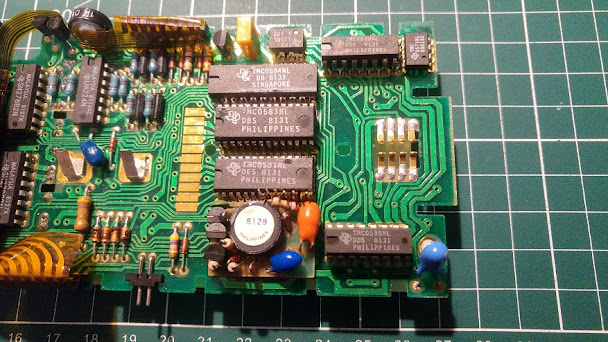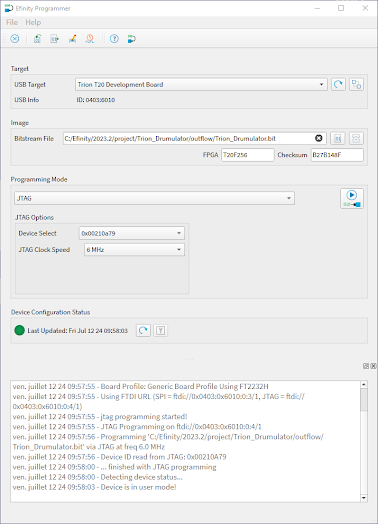Sometimes unexpected encounters happen. This time with a TI59 and its PC-100C printer.
In fact, a few days ago I was walking in a square somewhere in Brussels, where a garage sale was taking place.
And, while walking through the maze of pop-up shops, I come across a TI59 installed on its PC-100C printer.
 |
| wikimedia.org |
A few days later, during a break in my vacation wanderings, I couldn't resist the urge to test the set in my hotel room. After checking that the machine's fuse was in good condition, I tried connecting the PC-100C to the mains. And there: 'magic smoke' :-(
I suspected it a little. I wasn't too disappointed though, knowing that I bought the whole thing for €5, sold by someone who obviously knew nothing about it, and presented as an old cash register!
After a relaxing vacation and back home, I took the printer apart and discovered what I expected, namely a nice 'burned' tantalum capacitor.
This type of capacitor is quite annoying in the long term because it tends to generate a short circuit one day or another. And that's what happened. The capacitor was therefore completely destroyed, and this was the reason for the destruction of the protection fuse.
I therefore changed all of the capacitors of this type with good quality chemical versions. I won't have any more problems like this for a while.
And then I took the opportunity to inspect the electronic card of this printer a little more. Because I still found it a little strange that the recovered set was in such good condition. In fact, there are just the keys of the TI59 which are no longer very good on the surface. I assume the foam must be completely disintegrated.
And here is what I discovered:
And there you have it: two beautiful welds which are not original and which I discovered. Nothing serious at the moment, but this could indicate that the entire system was having operating problems. And therefore, it would not be impossible that despite my repair, the system still does not work.
And it is. Once you have reassembled the PC-100C and placed the TI59 on its support, of course, the red printer LED lights up, but nothing happens to the TI59. I don't even hear the little characteristic noise of the voltage booster module, such as I heard on my TI57... at the time. However, the printer does deliver -3.75V on its connector, to the 59.
Nothing happens to the printer either. Even the paper advance doesn't work. At this stage I haven't read the instructions manual, but I imagine that paper loading 'should' still be possible. It doesn't matter right now. First of all, and since it is the calculator which is the center of this system, I decide to look at it first. Fortunately I was able to find the diagram of the 59 and the PC100 on the Internet.
So at this point the next objective is to check what happens if I apply adequate voltage to the calculator and thus, I hope, determine where it is stuck. The first thing to do is to disassemble the TI59. Hmm... bad memories of my TI57 encourage me to be extremely careful. A broken plastic lug holding the keyboard, and it's ruined! No need to think about replacing it or regluing it: it doesn't hold, even with glue!
First operation, at risk, disassemble the TI59 without breaking anything! I achieved it :
 |
| The motherboard |
 |
| Displays & keyboard |
What I was thinking about the keyboard, namely that certain keys no longer rise correctly to the surface of the machine, actually comes from the fact that the foam which is supposed to place the keys towards the surface of the calculator, is in very poor condition :
And I didn't break any of the four lugs holding the keyboard/electronic card assembly in the body of the machine!
The first tests of connecting the machine to a voltage source of 3.75V gave me rather worrying results. I discovered consumption much higher than expected. After testing the capacitors and diodes on the board, I don't find anything special. This is even more worrying. And, of course, the machine won't start.
At this stage, I still have to discriminate whether it is the module which generates the two negative voltages -Vdd and -Vgg which poses a problem, or whether it is 'behind' that this is happening. So I need to remove this module from the TI59 card:
Powering up the machine does not generate significant consumption, knowing that without the module, only the -Vb voltage (the supply voltage of the machine in fact) is used. There is therefore no consumption on -Vdd and -Vgg :
I power the calculator at a little more than 3.7V knowing that I go through the power supply diodes.
Consumption is very low. Normal since I think none of the machine's circuits are working since they all use the other two voltages which are not present at the moment. I don't know how the logic circuits support this power condition anyway, but I don't really have a choice.
I therefore also checked the operation of the module which generates the two negative voltages -Vdd and -Vgg. I also obtain an idle consumption of only a few mA. The measured output voltages are -9V for -Vdd and -12V for -Vgg. This should be -15V for -Vgg but hey, that's not the topic at the moment.
Following these operations, I reassembled the module for testing the two negative voltages and turned the machine back on. The result was immediate with an overall consumption of almost 200mA. Something really unusual is happening. I know, however, that this is not on the -Vb and that the voltage module is not the cause either. I still have to check -Vdd and -Vgg.
While I still have -12V for -Vgg , I now find myself with -6V for -Vdd. I'm starting to better understand the problem with -Vdd. However, all integrated components use the three voltages. For discriminated against, well it’s relatively simple. Given that I have excessive current consumption, I then necessarily have a component which consumes this current and which therefore heats up.
So I decided to let the calculator 'warm up' for a few minutes. And indeed, after a certain time, I detected a component which was heating up while all the others remained cold.
The TMC0583 is clearly hot. It is therefore very likely that the problem with this ti59 comes from this component. However, I am not 100% sure because it is fixed on the TCM0582 which may also present a problem. The only way to check if my idea is the right one is to desolder and remove this TCM0583.
But in any case, and in accordance with the calculator diagram, if the TCM0582 or the TCM0583 is out of order, there can no longer be a display. Additionally, these two circuits contain the system ROM, so the calculator almost certainly cannot even boot anyway.
If my theory is confirmed, it will then be very difficult for me to restart this machine. It is not possible to find this type of component, even second-hand. I would then have to find a defective TI59 and try to recover the necessary component, provided that it is functional of course...
I was wrong all along, and here's why...
Following previous experiments, I decided to remove one of the components of the calculator, namely the TMC0583 because I found that it was hotter than the other components.
I find myself with a lower consumption of only 30mA compared to the consumption of the machine equipped with this TMC0583.
In the event of too high consumption of the calculator, this component is therefore not the main source of consumption. The doubt about the idea I have of the dysfunction grows. On the other hand, and interestingly, I leave the machine powered on for a certain time in order to control the temperature of the components.
After about 15 minutes, I realize that the temperature of the TMC0582, the component on which the TMC0583 is soldered, is also hot, but actually no hotter than the TMC0583. So I'm starting to think that potentially there are no defective components. But then, why doesn't the TI59 start?
In this case, I only see one reason: the conditions for starting the machine are not met. However, until now I have carried out the tests with the magnetic card reader removed. So I decide to reconnect this card reader. And what do you think happened?
Well yes, the machine starts. The card reader is under the sheet of paper to avoid possible short circuit. Note that at this precise moment, I did not put the TCM0583 back in place.
The machine functions normally, it recognizes Pi, but is unable to perform any mathematical operation whatsoever. Indeed, the code for the mathematical routines must be found in this TCM0583. It's quite 'amusing' to note that the absence of this ROM of mathematical functions does not absolutely crash the machine. The order is simply not fulfilled : cool!
Needless to say here, I think (but I do it anyway), that I am very happy with the result. I therefore decide to put the TCM0583 circuit back in place. Once the operation is completed, I switch to around 200mA consumption without using the card reader. This consumption varies depending on the number of digits lit on the display.
Now for tension control. Warning, the reference of the two negative voltages Vdd and Vgg must not be the ground, but in fact the positive power supply of the machine, therefore not -Vb (corresponding to the ground of the power supply supplied to the calculator) but the positive pole of this power supply. And as -Vb is equal to approximately -3.3V, we end up with -Vgg not at -12V, but -15V, and -Vdd not at -6V but at approximately -9V.
In reality, I measured not -9V for -Vdd but -8V real. Vgg being really at -15V. In short, all voltages seem good and consumption is stable at around 200mA.
After more than an hour of operation, all the measurements have not changed, a sign that everything is working. I was even able to enter a small program and run it. I hadn't done this kind of thing since I got rid of my TI57, 6 or 7 years (1988~1989) after buying it because the keyboard had become unusable. I tested a good number of keys on this TI59, the keyboard seems to be in good condition.
I obviously don't have much left to do on this calculator. I placed a solder spot on each expansion module connector tab. While wanting to test the voltages on this connector, one of the legs became detached from the card. I had to solder it.
Conclusion: I don't have an answer to why the calculator wouldn't start. However, I opt for a small contact problem on the flexible cables which connect the card reader to the calculator. However, these connectors firmly hold the tabs on the flexible cables. During my tests, I connected the power supply to the terminals of the blue power filter capacitor present at the bottom left of the TI card. Since then, I have connected the power supply directly to the dedicated pins of the machine by increasing the supplied voltage by 1.4V and everything works perfectly. I did not power the machine through its battery connector, I still have this test to carry out.
Would I have put this machine back into operation faster with the documentation? I don't know. Concerning the tensions, I did not see any mention of what the reference was. It is also not explicitly written that the card reader must be connected to the machine for it to start. 'Worse', while reading the documentation I let myself be 'influenced' by the troubleshooting advice stipulating that if nothing happens, then look at the TCM0583.
But hey, I didn't spend too much time on the machine, just over two hours. Everything is not finalized however. I still have to find a suitable foam to put on the keyboard before reassembling the machine. And I will also need to test the communication with the printer.












































